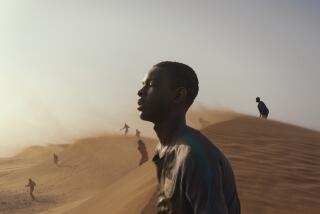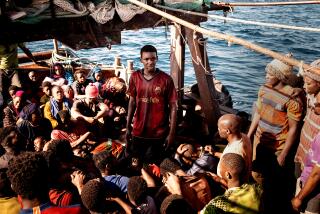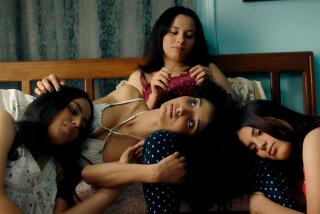Director Ai Weiwei’s ‘Human Flow’ finds the deep humanity in overwhelming refugee crisis

In late 2014, an Iraqi nonprofit asked famed Chinese artist-activist Ai Weiwei to help judge drawings made by religious minority Yazidi refugees. It was Ai’s first real connection with the global migrant catastrophe that ultimately swelled into the documentary “Human Flow,” a multinational epic of staggering beauty that premiered in September at the Venice International Film Festival. The topic: the 65 million refugees — from Turkey, Syria, Iraq, Nigeria, Sudan, Senegal and more — making up today’s massive worldwide relocation crisis. Ai, who recently returned to his Berlin home after extensive travel for the film, preferred to answer questions through an interpreter via email.
What were the project’s beginning stages and how did it evolve?
At the end of 2015, I traveled with my son and girlfriend to the Greek isle of Lesbos. As we walked along the shore, we saw a boat approach; I took out my phone and began recording. This was my first encounter with the refugees as they approached Lesbos. The image was so shocking I decided to move my studio to Lesbos to film.
WATCH: Video Q&A’s from this season’s hottest contenders >>
At the start, we never imagined the film would engage on a global scale or that it would have such a wide release in cinemas — I did not yet know how complex and broad this issue was. We quickly organized a research team and our first film crew. We spent one month on Lesbos and then decided to go to Turkey to see the other side of the sea where the refugees depart from. Gradually, we traveled to 23 nations, over 40 camps and conducted over 600 interviews spanning 900 hours of footage.

L.A. Times photo shoot with Ai Weiwei
The directorial viewpoints of the film (close-to-the-ground and high overhead drone shots) spliced together are compelling. Did you decide on this duo-viewpoint from the start or did it evolve?
The decision to use drones was made at the start. There were two reasons. First, it’s difficult to get on a boat, go out to sea and approach the refugee boats; there are many legal issues related to a civilian or volunteer team approaching so-called illegal migrants. Second, we wanted to show how small and fragile the boats are in the vast ocean and this could only be achieved with a view from above. The visual effect is very powerful as it not only presents the perspective of reality, but juxtaposes this desperate journey with the beautiful landscape, presenting a contradiction in emergency and tranquillity.
You appear at various times in the film. How did that come about?
My appearance in the film was not a conscious intention. We had many different teams shooting concurrently. Only during the editing process did we try to find some images of my involvement. Often, those moments were not shot on professional cameras, but the purpose of including those shots is clear: This film is not a historical record on refugees, but one individual — one artist’s — recorded effort toward the human condition. That involvement is a strong character of this film. It connects the film to the perspective of a single person, and provides an honest account of the filming process. Simply put, this film is about my research and knowledge of this global condition.
Whom do you want most to see this film?
I would like my son to see the film. He is 8 now. I would like his generation — those still in school — to understand this situation. They belong to a new world and they should understand what has — or hasn’t — been done by their parents’ generation.
[For] we cannot look at the current situation and decide it’s a regional problem. The name “Human Flow” comes from an understanding of the historical aspect of this; we cannot look at it as simply current affairs, but as something that has always been. And the crisis is now becoming increasingly harsh and difficult to understand, and has the potential to develop into an even larger problem. We need the film to reach the public, especially those in privileged nations with the ability to help.
What do you hope the film adds to the discussion of the world’s massive refugee crisis?
I hope it helps raise awareness of the refugee condition. We have to see humanity as one. If any individual’s rights have been violated and we are able to tolerate it, then all of humanity is damaged. If we can tolerate the fact that 65 million people have been forced from their homes, then this is truly the greatest human tragedy of the 21st century.
See the most read stories this hour »
More to Read
From the Oscars to the Emmys.
Get the Envelope newsletter for exclusive awards season coverage, behind-the-scenes stories from the Envelope podcast and columnist Glenn Whipp’s must-read analysis.
You may occasionally receive promotional content from the Los Angeles Times.






